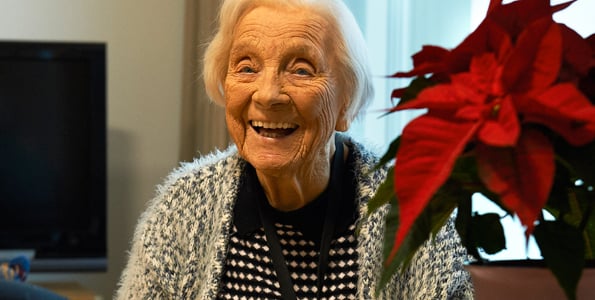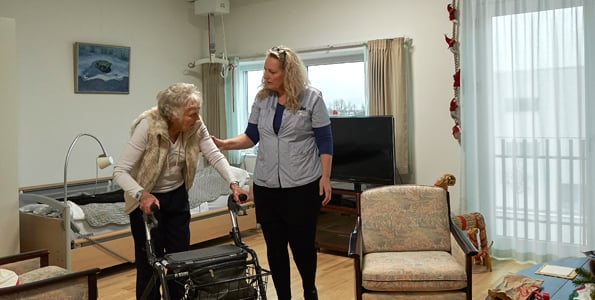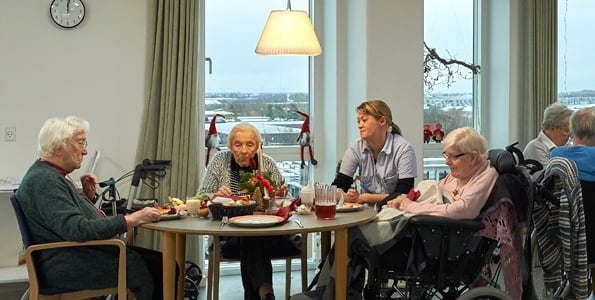Can Circadian Lighting ensure a smoother transition from home to nursing home while also improving the quality of life and health of the elderly? This is the question that a new research project aims to answer.
In the coming years, the number of elderly individuals with dementia in nursing homes is expected to increase, without a corresponding increase in staffing. In Albertslund, they are exploring the potential of circadian lighting as part of the solution to ensure quality care and dignity for the elderly in the future. To investigate and document the effectiveness of this welfare technology, the municipality has initiated a project called Lightel, in collaboration with researchers and lighting experts. Supported by ELFORSK, the project has implemented circadian lighting at the Albertshøj Nursing Home.
— Many of our elderly residents move into the care centre with some form of disruption in their sleep patterns. This can lead to poor sleep and daytime fatigue, ultimately impacting their overall quality of life. By implementing circadian lighting, we expect to see a noticeable improvement in the residents' sleep patterns and overall well-being, explains Mona Funch, Care Center Manager at Albertslund Municipality.
We anticipate that the elderly residents will experience improved well-being as a result of getting a good night's sleep. Their concentration is expected to improve, and they will have a greater desire and ability to actively engage in daily activities.
— Mona Funch, Care Center Manager
Denmark is leading the way in circadian lighting technology, and a recent study conducted by Rigshospitalet showed the positive impact of circadian lighting on depression, fatigue, and sleep patterns in hospitalized patients. In the field of elderly care, over 30 nursing homes have already implemented circadian lighting with great success.
The Lightel project is now taking a step forward and investigating the impact of circadian lighting on individuals with dementia in relation to their health and quality of life. If the results are positive, circadian lighting will become an area that the municipality will further invest in, explains project leader Kristina Aggergaard from Albertslund Municipality.
We are investigating whether circadian lighting can contribute to enhancing their functional level or slowing down its decline, thereby strengthening the quality of life and dignity of the elderly and facilitating the transition to nursing homes.
— Linda Andresen, Laboratory and Head of Staff at the Clinical Research Center
Focus on the elderly
The research is being conducted by an interdisciplinary team consisting of members from Klinisk Forskningscenter, Hvidovre Hospital, as well as anthropological lighting designers from Aalborg University Copenhagen.
— We aim to document whether circadian lighting is an effective technology for the elderly. The elderly are often fragile and have undergone a significant change from living in their own homes to moving to nursing homes, explains Linda Andresen.

The study methodology involves initially exposing the nursing home to normal lighting for 8 weeks, followed by 8 weeks of circadian lighting. Throughout this period, various investigations, observations, and staff involvement will be conducted to measure the impact on the residents in terms of the ageing process, disease risk, as well as the quality of life, appetite, depression, delirium, sleep, symptoms of dementia, and mobility.
In addition, the study will explore the significance of circadian lighting for the elderly and how it influences their daily lives. Approximately 33 residents and 35 staff members are participating in the study.
Furthermore, researchers from Aalborg University will measure and simulate the total amount of light the elderly receive, taking into account both natural light from outside and circadian lighting.
Denmark's leading position in lighting technology
The circadian lighting used in the project was developed by Chromaviso, a company specializing in health-promoting and evidence-based lighting solutions. They have extensive experience in this field, including previous research projects conducted at Rigshospitalet.
We have tailored the circadian lighting to the needs of individuals with dementia, ensuring that it supports the well-being of the residents, enhances the work of the staff, and facilitates the activities at the nursing home throughout the day. It is a comprehensive solution that becomes an integral part of providing excellent care.
— Torben Skov Hansen, Chief Technology Officer at Chromaviso
Therefore, Lightel is building upon existing research and knowledge. However, it was not initially expected that the lighting would be Danish, and the project first looked to larger, international players.
— We are delighted to collaborate with Chromaviso, a leading company in the field of circadian lighting. Their high-quality fixtures, combined with their extensive knowledge and experience, make them a valuable contributor to the project at every stage, from consultation to implementation, explains Kristina Aggergaard.
Great improvement for patients and citizens
In addition, the head of the department for Living Labs at Gate 21, responsible for reporting to ELFORSK and disseminating Lightel, anticipates that the project will establish Denmark as a leading force in an international context.
— If the circadian lighting can be further documented and integrated into the treatment and prevention of the Danish healthcare system, it will be a significant boost for patients and citizens. Additionally, it will result in cost savings for the government due to the energy-saving benefits of LED technology. Hopefully, Danish companies will be at the forefront when the implementation begins, as it will create job opportunities in Denmark, says Jacob Lundgaard.
The results of the study are expected to be ready in early 2019 and will be published in scientific journals. After the experiment is completed, Albertshøj Care Center will continue to implement circadian lighting.

Homes
Circadian lighting is installed in the residents' homes. It gradually turns on in the morning and turns off at night. In the bathroom, a soft night light is illuminated, providing comfort and guidance during nighttime awakenings and bathroom visits.
Hallways
In the hallways, the circadian lighting operates throughout the day, providing a soothing and natural ambience. During the night, a specially designed night light without the disruptive blue tones is activated, signalling to the residents that it is time to sleep while still providing adequate lighting for the staff's work.
Common areas
In the living rooms, dining rooms, and kitchen, circadian lighting helps create a welcoming and cozy atmosphere, enhancing energy and enjoyment during meals and other activities.

About the project
Albertslund Municipality, Klinisk Forskningscenter Hvidovre Hospital, Aalborg University Copenhagen, Gate 21, and Chromaviso have joined forces to implement and document circadian lighting at Albertshøj Care Center. This interdisciplinary, public-private collaboration is supported by ELFORSK, with additional funding from the Danish-Swedish innovation project Lighting Metropolis.
About Circadian Lighting
The circadian lighting developed by Danish company Chromaviso follows the natural cycle of day and night, gradually changing in colour temperature and intensity. It mimics the rising of the sun in the morning and is at its brightest during midday. At night, the lighting in the residents' rooms is dimmed to create a dark environment, while warm night lights without disruptive blue tones are used in hallways and common areas to promote a healthy sleep-wake cycle. These lighting solutions have been developed based on clinical research and in collaboration with sleep experts and researchers from Rigshospitalet Glostrup and Aarhus University Hospital. The aim is to enhance the well-being and quality of life of the elderly residents at Albertshøj Care Center by incorporating circadian lighting into their daily routines.
Based on science
It is based on a clinically documented lighting protocol that Chromaviso has developed in collaboration with sleep experts and researchers from Rigshospitalet Glostrup and Aarhus University Hospital. At the same time, the circadian lighting solution takes into account the different situations throughout the day where light plays a role.
For example, at night, warm orientation lights help the residents navigate to the toilet and back to bed, or night work lights can be used when staff members require more light for caregiving.

About the research at the Clinical Research Center, Hvidovre Hospital, and Aalborg University
Objective
The research project aims to investigate the impact of circadian lighting on the residents of Albertshøj Care Center in relation to:
- Aging process
- Disease risk
- Quality of life
- Appetite
- Depression
- Delirium
- Sleep patterns
- Mobility
- Symptoms of dementia
- Daily routines and habits
Methodology
The study covers all aspects of the residents' lives - first in normal lighting (8 weeks) and then in circadian lighting (8 weeks). The investigation includes analyzing biomarkers and functional levels, collecting data from questionnaires, making observations, conducting interviews, and involving staff members.
This is complemented by an anthropological approach that explores what it means for the elderly to have circadian lighting and how it influences their daily lives.
A total of approximately 33 residents and 35 staff members are participating in the study. Researchers from Aalborg University are also measuring and simulating the total amount of light the elderly receive - both from natural light outside and circadian lighting.

Partners:
The project partners include:- Kristina Aggergaard, Project Manager from Albertslund Municipality.
- Linda Andresen, Laboratory and Head of Staff at the Clinical Research Center, Hvidovre Hospital.
- Georgios Triantafyllidis, Associate Professor at Aalborg University Copenhagen.
- Jacob Lundgaard, Department Manager at Gate 21.
- Torben Skov Hansen, Chief Technology Officer at Chromaviso.
The project has received funding from ELFORSK, Albertslund Municipality, and Lighting Metropolis to support its implementation.

